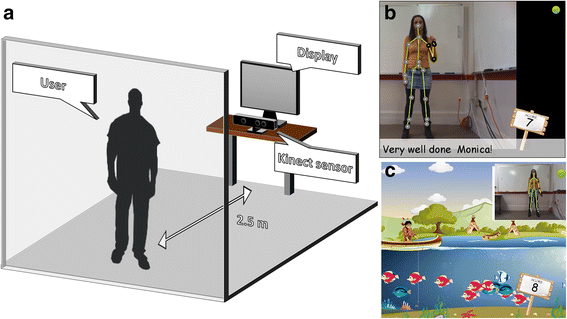Coaching or gaming? Implications of strategy choice for home based stroke rehabilitation
The enduring aging of the world population and prospective increase of age-related chronic diseases urge the implementation of new models for healthcare delivery. One strategy relies on ICT (Information and Communications Technology) home-based solutions allowing clients to pursue their treatments without institutionalization. Stroke survivors are a particular population that could strongly benefit from such solutions, but is not yet clear what the best approach is for bringing forth an adequate and sustainable usage of home-based rehabilitation systems. Here we explore two possible approaches: coaching and gaming.
We performed trials with 20 healthy participants and 5 chronic stroke survivors to study and compare execution of an elbow flexion and extension task when performed within a coaching mode that provides encouragement or within a gaming mode. For each mode we analyzed compliance, arm movement kinematics and task scores. In addition, we assessed the usability and acceptance of the proposed modes through a customized self-report questionnaire.
In the healthy participants sample, 13/20 preferred the gaming mode and rated it as being significantly more fun (p < .05), but the feedback delivered by the coaching mode was subjectively perceived as being more useful (p < .01). In addition, the activity level (number of repetitions and total movement of the end effector) was significantly higher (p < .001) during coaching. However, the quality of movements was superior in gaming with a trend towards shorter movement duration (p = .074), significantly shorter travel distance (p < .001), higher movement efficiency (p < .001) and higher performance scores (p < .001). Stroke survivors also showed a trend towards higher activity levels in coaching, but with more movement quality during gaming. Finally, both training modes showed overall high acceptance.
Gaming led to higher enjoyment and increased quality in movement execution in healthy participants. However, we observed that game mechanics strongly determined user behavior and limited activity levels. In contrast, coaching generated higher activity levels. Hence, the purpose of treatment and profile of end-users has to be considered when deciding on the most adequate approach for home based stroke rehabilitation.
Reference:
Mónica S. Cameirão, Asim Smailagic, Guangyao Miao and Dan P. Siewiorek. Coaching or gaming? Implications of strategy choice for home based stroke rehabilitation. Journal of NeuroEngineering and Rehabilitation, 2016, 13:18, DOI: 10.1186/s12984-016-0127-8



Comments